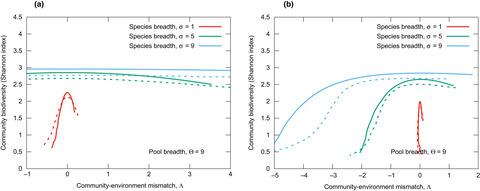当前位置:
X-MOL 学术
›
Ecol. Lett.
›
论文详情
Our official English website, www.x-mol.net, welcomes your
feedback! (Note: you will need to create a separate account there.)
Shape of species climate response curves affects community response to climate change
Ecology Letters ( IF 7.6 ) Pub Date : 2021-02-14 , DOI: 10.1111/ele.13688 Juan A. Bonachela 1 , Michael T. Burrows 2 , Malin L. Pinsky 1
Ecology Letters ( IF 7.6 ) Pub Date : 2021-02-14 , DOI: 10.1111/ele.13688 Juan A. Bonachela 1 , Michael T. Burrows 2 , Malin L. Pinsky 1
Affiliation

|
Understanding how community composition is reshaped by changing climate is important for interpreting and predicting patterns of community assembly through time or across space. Community composition often does not perfectly correspond to expectations from current environmental conditions, leading to community‐climate mismatches. Here, we combine data analysis and theory development to explore how species climate response curves affect the community response to climate change. We show that strong mismatches between community and climate can appear in the absence of demographic delays or limited species pools. Communities simulated using species response curves showed temporal changes of similar magnitude to those observed in natural communities of fishes and plankton, suggesting no overall delays in community change despite substantial unexplained variation from community assembly and other processes. Our approach can be considered as a null model that will be important to use when interpreting observed community responses to climate change and variability.
中文翻译:

物种气候响应曲线的形状影响社区对气候变化的响应
了解气候变化如何重塑社区组成对于解释和预测跨时间或跨空间的社区聚集模式非常重要。社区组成常常不能完全符合当前环境条件的预期,从而导致社区与气候之间的不匹配。在这里,我们将数据分析与理论发展相结合,以探索物种气候响应曲线如何影响社区对气候变化的响应。我们表明,在没有人口统计学延迟或物种库数量有限的情况下,社区和气候之间可能会出现严重的不匹配现象。使用物种反应曲线模拟的社区显示出与鱼类和浮游生物自然社区中观察到的时间变化幅度相似的时间变化,提示尽管社区组装和其他流程发生了无法解释的巨大变化,但社区变更没有整体延迟。我们的方法可以被认为是一个零模型,在解释观察到的社区对气候变化和变异的响应时,将使用该方法很重要。
更新日期:2021-03-16
中文翻译:

物种气候响应曲线的形状影响社区对气候变化的响应
了解气候变化如何重塑社区组成对于解释和预测跨时间或跨空间的社区聚集模式非常重要。社区组成常常不能完全符合当前环境条件的预期,从而导致社区与气候之间的不匹配。在这里,我们将数据分析与理论发展相结合,以探索物种气候响应曲线如何影响社区对气候变化的响应。我们表明,在没有人口统计学延迟或物种库数量有限的情况下,社区和气候之间可能会出现严重的不匹配现象。使用物种反应曲线模拟的社区显示出与鱼类和浮游生物自然社区中观察到的时间变化幅度相似的时间变化,提示尽管社区组装和其他流程发生了无法解释的巨大变化,但社区变更没有整体延迟。我们的方法可以被认为是一个零模型,在解释观察到的社区对气候变化和变异的响应时,将使用该方法很重要。









































 京公网安备 11010802027423号
京公网安备 11010802027423号